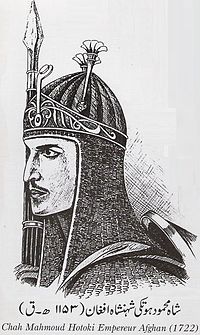Shah Mahmud
|
Shah Mahmud Hotak (King Mahmud I) شاه محمود هوتک |
|||||
|---|---|---|---|---|---|
| Ghazi Emir of Afghanistan Shahanshah of Iran  |
|||||

Sketch work of Mir Mahmud Shah
|
|||||
| Reign | Hotak Empire: 1717–1725 | ||||
| Coronation | 1717 and 1722 | ||||
| Predecessor | Abdul Aziz Hotak | ||||
| Successor | Ashraf Hotak | ||||
| Born | 1697 | ||||
| Died | April 22, 1725 Isfahan |
||||
| Consort | Shahbanu Alamiyan Govhar Sultan Safavi | ||||
|
|||||
| Dynasty | Hotak dynasty | ||||
| Father | Mirwais Khan Hotak | ||||
| Religion | Sunni Islam | ||||
| Full name | |
|---|---|
| Mir Mahmud Shah Hotak |
Shāh Mahmūd Hotak, (Pashto, Dari: شاه محمود هوتک), also known as Shāh Mahmūd Ghiljī (Pashto: شاه محمود غلجي) (lived 1697 – April 22, 1725), was an Afghan ruler of the Hotak dynasty who overthrew the heavily declined Safavid dynasty to briefly become the king of Persia from 1722 until his death in 1725.
He was the eldest son of Mirwais Hotak, the chief of the Ghilji Pashtun tribe of Afghanistan, who had made the Kandahar region independent from Persian rule in 1709. When Mirwais died in 1715, he was succeeded by his brother, Abdul Aziz, but the Ghilji Afghans persuaded Mahmud to seize power for himself and in 1717 he overthrew and killed his uncle.
In 1720, Mahmud and the Ghiljis defeated the rival ethnic Afghan tribe of the Abdalis. However, Mahmud had designs on the Persian empire itself. He had already launched an expedition against Kerman in 1719 and in 1721 he besieged the city again. Failing in this attempt and in another siege on Yazd, in early 1722, Mahmud turned his attention to the shah's capital Isfahan, after first defeating the Persians at the Battle of Gulnabad. Rather than biding his time within the city and resisting a siege in which the small Afghan army was unlikely to succeed, Sultan Husayn marched out to meet Mahmud's force at Golnabad. Here, on March 8, the Persian royal army was thoroughly routed and fled back to Isfahan in disarray. The shah was urged to escape to the provinces to raise more troops but he decided to remain in the capital which was now encircled by the Afghans. Mahmud's siege of Isfahan lasted from March to October, 1722. Lacking artillery, he was forced to resort to a long blockade in the hope of starving the Persians into submission. Sultan Husayn's command during the siege displayed his customary lack of decisiveness and the loyalty of his provincial governors wavered in the face of such incompetence. Starvation and disease finally forced Isfahan into submission (it is estimated that 80,000 of its inhabitants died during the siege). On October 23, Sultan Husayn abdicated and acknowledged Mahmud as the new shah of Persia.
...
Wikipedia
